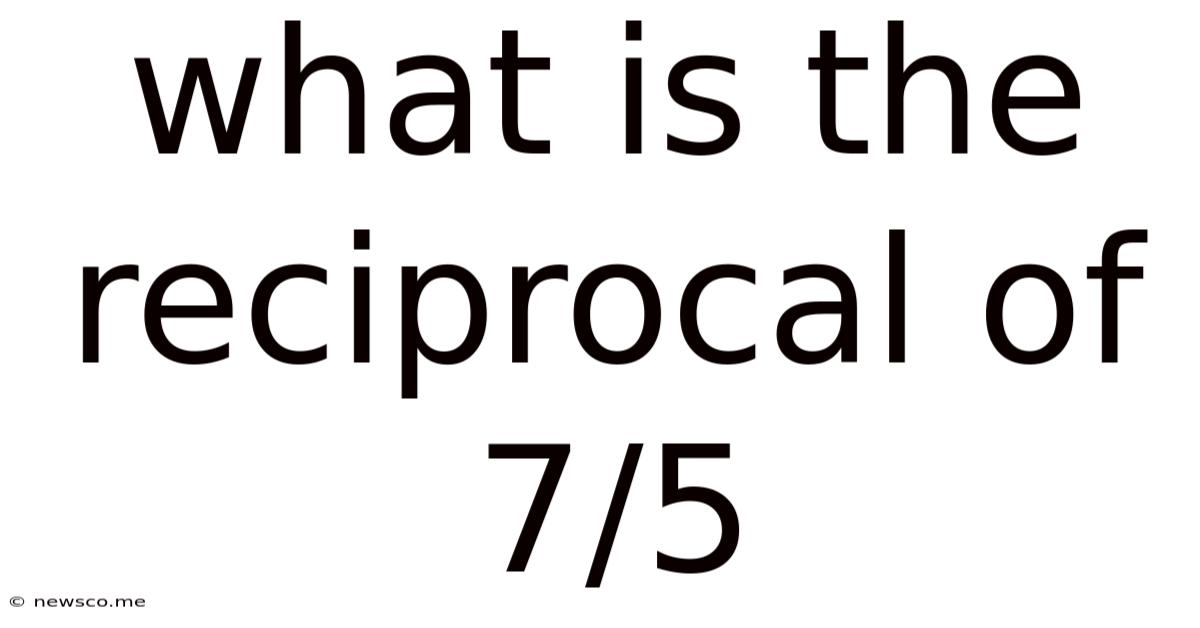What Is The Reciprocal Of 7/5
News Co
May 08, 2025 · 5 min read

Table of Contents
What is the Reciprocal of 7/5? A Deep Dive into Reciprocals and Their Applications
The question, "What is the reciprocal of 7/5?" seems simple enough. However, understanding reciprocals goes beyond simply flipping a fraction. This article will not only answer that question directly but also explore the concept of reciprocals in depth, examining their properties, applications in various mathematical fields, and their significance in solving real-world problems.
Understanding Reciprocals: The Basics
A reciprocal, also known as a multiplicative inverse, is a number that, when multiplied by the original number, results in a product of 1. In simpler terms, it's the number you need to multiply a given number by to get 1.
For example:
- The reciprocal of 2 is 1/2 (because 2 * 1/2 = 1).
- The reciprocal of 5 is 1/5 (because 5 * 1/5 = 1).
- The reciprocal of 1/3 is 3 (because 1/3 * 3 = 1).
This concept applies to all numbers except zero. Zero does not have a reciprocal because there's no number that, when multiplied by zero, equals 1.
Finding the Reciprocal of 7/5
Now, let's answer the initial question: What is the reciprocal of 7/5?
To find the reciprocal of a fraction, simply invert the fraction. This means swapping the numerator (the top number) and the denominator (the bottom number).
Therefore, the reciprocal of 7/5 is 5/7. We can verify this by multiplying the original fraction by its reciprocal:
7/5 * 5/7 = (7 * 5) / (5 * 7) = 35/35 = 1
Reciprocals of Whole Numbers and Decimals
The concept of reciprocals extends beyond fractions.
-
Whole Numbers: A whole number can be expressed as a fraction with a denominator of 1 (e.g., 3 = 3/1). Its reciprocal is simply the fraction with the numerator and denominator swapped (e.g., the reciprocal of 3 is 1/3).
-
Decimals: To find the reciprocal of a decimal, first convert the decimal to a fraction, then find the reciprocal of the fraction. For example, the reciprocal of 0.25 (which is 1/4) is 4/1 or 4.
Applications of Reciprocals in Mathematics
Reciprocals play a crucial role in various areas of mathematics:
1. Division:
Division is essentially multiplication by the reciprocal. Instead of dividing by a number, you can multiply by its reciprocal. For example:
10 ÷ 2 = 10 * (1/2) = 5
This principle is particularly useful when working with fractions. Dividing by a fraction is equivalent to multiplying by its reciprocal.
2. Solving Equations:
Reciprocals are frequently used to solve algebraic equations involving fractions or decimals. By multiplying both sides of an equation by the reciprocal of a coefficient, you can isolate the variable.
For example, to solve the equation (7/5)x = 14, you would multiply both sides by the reciprocal of 7/5, which is 5/7:
(5/7) * (7/5)x = 14 * (5/7) x = 10
3. Matrix Algebra:
In linear algebra, the concept of the reciprocal extends to matrices. The reciprocal of a matrix is known as its inverse. Finding the inverse of a matrix is a fundamental operation in solving systems of linear equations and performing other matrix manipulations. However, not all matrices have inverses. Matrices with a determinant of zero are called singular matrices and do not possess inverses.
4. Calculus:
Reciprocals appear in various calculus concepts. For example, the derivative of a function is often expressed using reciprocals, and they play a significant role in integration techniques.
Reciprocals in Real-World Applications
The seemingly abstract concept of reciprocals finds practical applications in various real-world scenarios:
1. Physics:
In physics, reciprocals are used extensively in formulas related to:
- Optics: Lens formulas often involve reciprocals of focal lengths.
- Electricity: Ohm's Law (V = IR) can be rearranged to find resistance (R = V/I), where the reciprocal of current (I) is involved.
- Mechanics: Formulas involving velocity, acceleration, and time frequently utilize reciprocals.
2. Finance:
Reciprocals are used in financial calculations involving interest rates, compound interest, and present value/future value calculations. Understanding reciprocals helps in manipulating these formulas effectively.
3. Engineering:
Various engineering disciplines utilize reciprocals in their formulas and calculations. Examples include civil engineering (structural analysis), mechanical engineering (fluid dynamics), and electrical engineering (circuit analysis).
4. Computer Science:
In computer science, reciprocals are used in various algorithms and computations, including those related to graphics processing, signal processing, and machine learning.
Beyond the Basics: Exploring More Complex Reciprocals
The concept of reciprocals extends to more complex number systems beyond the real numbers:
-
Complex Numbers: A complex number has a real and an imaginary part (a + bi, where 'i' is the imaginary unit, √-1). The reciprocal of a complex number can be found by multiplying the numerator and the denominator by the complex conjugate of the denominator.
-
Quaternions: Quaternions are a number system extending complex numbers, used extensively in computer graphics and other areas. They also have reciprocals, though their calculation is more involved.
Conclusion: The Importance of Understanding Reciprocals
The seemingly simple question of finding the reciprocal of 7/5 opens a door to a wide range of mathematical concepts and their real-world applications. From solving basic equations to tackling advanced problems in physics, engineering, and computer science, a thorough understanding of reciprocals is essential. This article aimed to provide a comprehensive overview, highlighting not only the mechanics of finding reciprocals but also their significance and relevance in diverse fields. The ability to manipulate and understand reciprocals forms a crucial foundation for further mathematical exploration and problem-solving. Mastering this concept paves the way for a deeper understanding of various mathematical and scientific principles.
Latest Posts
Related Post
Thank you for visiting our website which covers about What Is The Reciprocal Of 7/5 . We hope the information provided has been useful to you. Feel free to contact us if you have any questions or need further assistance. See you next time and don't miss to bookmark.